Surface Engineering of Auxetic Scaffolds for Neural and Vascular Differentiation from Human Pluripotent Stem Cells
- PMID: 36403987
- PMCID: PMC9992167
- DOI: 10.1002/adhm.202202511
Surface Engineering of Auxetic Scaffolds for Neural and Vascular Differentiation from Human Pluripotent Stem Cells
Abstract
Auxetic materials are the materials that can display negative Poisson's ratio that describes the degree to which a material contracts (or expands) transversally when axially strained. Human stem cells sense the mechanical properties of the microenvironment, including material surface properties, stiffness, and Poisson's ratio. In this study, six different auxetic polyurethane (PU) foams with different elastic modulus (0.7-1.8 kPa) and Poisson's ratio (-0.1 to -0.5) are used to investigate lineage specification of human induced pluripotent stem cells (hiPSCs). The surfaces of the foams are modified with chitosan or heparin to enhance the adhesion and proliferation of hiPSCs. Then, the vascular and neural differentiation of hiPSCs are investigated on different foams with distinct elastic modulus and Poisson's ratio. With different auxetic foams, cells show differential adherent density and differentiation capacity. Chitosan and heparin surface functionalization promote the hindbrain and hippocampal markers, but not forebrain markers during neural patterning of hiPSCs. Properly surface engineered auxetic scaffolds can also promote vascular differentiation of hiPSCs. This study represents a versatile and multifunctional scaffold fabrication approach and can lead to a suitable system for establishing hiPSC culture models in applications of neurovascular disease modeling and drug screening.
Keywords: Poisson's ratio; auxetic scaffolds; elastic modulus; human pluripotent stem cells; neural differentiation; vascular differentiation.
© 2022 Wiley-VCH GmbH.
Conflict of interest statement
Conflict of Interest:
There is no conflict of interest.
Figures




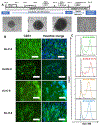
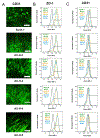
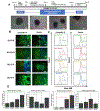
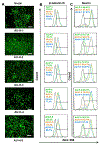
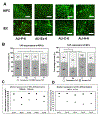
Similar articles
-
Pluripotent stem cell expansion and neural differentiation in 3-D scaffolds of tunable Poisson's ratio.Acta Biomater. 2017 Feb;49:192-203. doi: 10.1016/j.actbio.2016.11.025. Epub 2016 Nov 11. Acta Biomater. 2017. PMID: 27845272
-
Vascular differentiation from pluripotent stem cells in 3-D auxetic scaffolds.J Tissue Eng Regen Med. 2018 Jul;12(7):1679-1689. doi: 10.1002/term.2695. Epub 2018 May 30. J Tissue Eng Regen Med. 2018. PMID: 29749038
-
Bone cell response to additively manufactured 3D micro-architectures with controlled Poisson's ratio: Auxetic vs. non-auxetic meta-biomaterials.Acta Biomater. 2024 Mar 15;177:228-242. doi: 10.1016/j.actbio.2024.01.045. Epub 2024 Feb 6. Acta Biomater. 2024. PMID: 38325707
-
Auxetic Structures for Tissue Engineering Scaffolds and Biomedical Devices.Materials (Basel). 2021 Nov 12;14(22):6821. doi: 10.3390/ma14226821. Materials (Basel). 2021. PMID: 34832223 Free PMC article. Review.
-
Engineering Brain-Specific Pericytes from Human Pluripotent Stem Cells.Tissue Eng Part B Rev. 2020 Aug;26(4):367-382. doi: 10.1089/ten.TEB.2020.0091. Tissue Eng Part B Rev. 2020. PMID: 32571167 Free PMC article. Review.
Cited by
-
Profiling biomanufactured extracellular vesicles of human forebrain spheroids in a Vertical-Wheel Bioreactor.J Extracell Biol. 2024 Aug 28;3(9):e70002. doi: 10.1002/jex2.70002. eCollection 2024 Sep. J Extracell Biol. 2024. PMID: 39211409 Free PMC article.
-
Composite patch with negative Poisson's ratio mimicking cardiac mechanical properties: Design, experiment and simulation.Mater Today Bio. 2024 May 22;26:101098. doi: 10.1016/j.mtbio.2024.101098. eCollection 2024 Jun. Mater Today Bio. 2024. PMID: 38840795 Free PMC article.
-
Viscoelasticity of Hyaluronic Acid Hydrogels Regulates Human Pluripotent Stem Cell-derived Spinal Cord Organoid Patterning and Vascularization.Adv Healthc Mater. 2024 Dec;13(32):e2402199. doi: 10.1002/adhm.202402199. Epub 2024 Sep 19. Adv Healthc Mater. 2024. PMID: 39300854 Free PMC article.
-
A Split-Plot Experimentation Strategy for Making Causal Inferences in Advanced Materials: Auxetic Polyurethane Foam Manufacturing and Processing Analysis.Materials (Basel). 2024 Jul 3;17(13):3280. doi: 10.3390/ma17133280. Materials (Basel). 2024. PMID: 38998362 Free PMC article.
References
-
- Lakes R, Science 1987, 235, 1038. - PubMed
-
- He C, Liu P, McMullan PJ, Griffin AC, physica status solidi (b) 2005, 242, 576
- Nkansah M, Evans K, Hutchinson I, Modelling and Simulation in Materials Science and Engineering 1994, 2, 337
- Gatt R, Zammit V, Caruana C, Grima JN, physica status solidi (b) 2008, 245, 502.
Publication types
MeSH terms
Substances
Grants and funding
LinkOut - more resources
Full Text Sources

